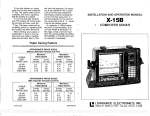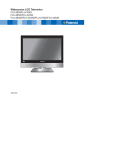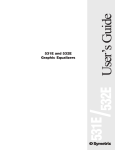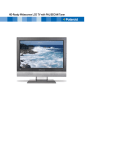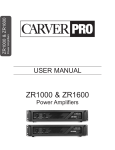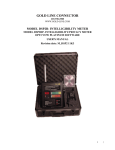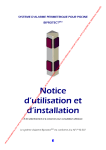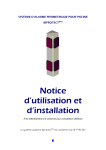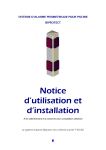Download QSC DSP-30 Hardware manual
Transcript
Hardware Manual DSP-30 Computer Configurable Digital Signal Processor *TD-000097-00* TD-000097-00 Rev.C 1 WARNING! WHILE QSC HAS ENDEAVORED TO DEVELOP AND PRODUCE THE MOST DEPENDABLE AND ROBUST DIGITAL SIGNAL PROCESSOR (DSP) AUDIO PRODUCT FOR YOUR USE, DUE TO THE UNLIMITED AND POTENTIALLY DESTRUCTIVE (TO THE SOUND SYSTEM) CONFIGURATIONS THAT MAY BE APPLIED TO THE DSP BY THE USER, QSC CANNOT BE HELD RESPONSIBLE FOR DAMAGES RESULTING FROM ANY DEVIATION OR FAILURE BY THE USER TO STRICTLY FOLLOW THE RECOMMENDATIONS SET FORTH IN THE OWNER’S MANUAL FOR THE INTEGRATION OF THE DSP AND SIGNAL MANAGER SOFTWARE WITH YOUR SOUND SYSTEM. ALL RISKS ATTENDANT TO INTEGRATION OF USER-CONFIGURABLE DSP PRODUCTS WITH YOUR SOUND SYSTEM ARE ASSUMED BY YOU. WHILE QSC STRIVES TO SUPPLY THE HIGHEST QUALITY TECHNICAL SOLUTIONS FOR DIGITAL SIGNAL PROCESSING, IN NO EVENT WILL QSC OR ITS SUPPLIERS BE HELD LIABLE FOR ANY DAMAGES, CONSEQUENTIAL, INCIDENTAL, OR OTHERWISE, INCLUDING ANY CLAIMS FOR LOST PROFITS AND/OR SAVINGS RESULTING FROM ANY ATTEMPTED INTEGRATION OF THE DSP AND SIGNAL MANAGER SOFTWARE WHICH DOES NOT STRICTLY ADHERE TO THE MANUAL’S RECOMMENDATIONS. IMPORTANT SAFETY INFORMATION: PLEASE REVIEW! EXPLANATION OF GRAPHICAL SYMBOLS Federal Communications Commission (FCC) Information NOTE: This equipment has been tested and found to comply with the limits for a The lightning flash with arrowhead symbol, within an equilateral triangle, is intended to alert the user to the presence of uninsulated “dangerous voltage” within the product’s enclosure that may be of sufficient magnitude to constitute a risk of electric shock to humans. The exclamation point within an equilateral triangle is intended to alert the users to the presence of important operating and maintenance (servicing) instructions in the literature accompanying the product. Class B digital device, pursuant to Part 15 of the FCC Rules. These limits are de- CAUTION signed to provide reasonable protection RISK OF ELECTRIC SHOCK DO NOT OPEN against harmful interference in a commercial installation. This equipment generates, uses, and can radiate radio frequency energy and, if not installed and used in accordance with the instructions, may cause harmful interference to radio communications. Operation of this equipment in a residential area is likely to cause harmful interference, in which case the user will be required to correct the interference at his or her own expense. CAUTION: To reduce the risk of electric shock, do not remove the cover. No user-serviceable parts inside. Refer servicing to qualified service personnel. WARNING: To prevent fire or electric shock, do not expose this equipment to rain or moisture. SAFEGUARDS Electrical energy can perform many useful functions. This unit has been engineered and manufactured to assure your personal safety. Improper use can result in potential electrical shock or fire hazards. In order not to defeat the safeguards, observe the following instructions for its installation, use and servicing. 2 Table of Contents INTRODUCTION Product Overview..................................................................4 Front and Rear Panel Illustrations and Dimensions.................4 INSTALLATION Unpacking..................................................................................................6 What is Included...................................................................................6 Mounting............................................................................................6 Connections: Balanced Audio Connector Pinouts........................7 Unbalanced Audio Connector Pinouts................................8 Audio Inputs and Outputs..........................................9 RS-232 Port....................................................................10 System Requirements...........................................................................11 Software Installation...........................................................................11 USE Control, Indicator, and Connector Descriptions..................12 General Use Guidelines.................................................................14 Presets....................................................................................15 How to save presets into the DSP-30...........................................15 How to recall Presets ...............................................................16 Lockout feature use.......................................................................17 Contact closure Feature .............................................................18 RS-232 pinout.........................................................................19 Application Example....................................................................20 SPECIFICATIONS.......................................................................................................................................................22 ARCHITECT’S & ENGINEER’S SPECIFICATION ..............................................................................................24 QSC INFORMATION Maintenance, Warranty & QSC Contact Information................................25 © Copyright 2002, QSC Audio Products, Inc. QSC® is a registered trademark of QSC Audio Products, Inc., Costa Mesa, CA “QSC” and the QSC logo are registered with the U.S. Patent and Trademark Office 3 Introduction: Overview and Illustrations Overview The DSP-30 and Signal Manager software combine easy-touse, customizable, two-channel DSP with simple operatingmode selection that requires only two buttons to operate. It can be used with all amplifiers and is housed in a 1-RU , 19-inch rack-mount steel chassis. Sampling frequency is 48 kHz. with 24-bit resolution. Dynamic range is greater than 93dB. It is absolutely rugged and dependable in the spirit of all QSC professional audio products and fully suited for the rigors of touring use. Processing capabilities of the DSP-30 include compressors, limiters, delays, parametric EQ, high/low pass filters, high/low shelf filters, test signal generators (sine-wave, pink- and white-noise), splitters/mixers, polarity reversal, gain/attenuation, and metering. A feature called “Predictive Delay” enables the DSP-30’s compressors and limiters to produce less signal distortion than their analog counterparts, especially for fast attack times. Predictive delay adds time delay to the signal path and must be accounted for to maintain proper time allignment. Using the Signal Manager software, predictive delay may be turned on or off; when on, it will provide time delay information to the operator. The DSP-30 provides powerful signal processing while keeping operation as simple. Preset operating modes are userselectable by scrolling through the list of numbered Presets on the front panel display and selecting. The DSP-30 will mute, Front Panel Power ‘on’ indicator LED Power switch reconfigure, and unmute in a fraction of a second, providing smooth transitions free of thumps, clicks and other undesirable audio artifacts. The contact closure input feature allows for instantaneous gain changing and other programmable uses. Use the QSC Signal Manager software to create the preset configurations. Please refer to page 11 for computer system requirements and software installation guidelines. For instructions for creating a simple signal processing chain, refer to the software help file. QSC’s Signal Manager software provides an easy-to-use graphical user interface where DSP “objects” are placed onto a workspace and interconnects are drawn. This interface allows almost infinite configuration possibilities. Signal Manager transfers the preset data to the DSP-30 through a serial data cable. The cable connects between the computer’s COM port and the DSP-30’s RS-232 port. Once the presets have been loaded, connection to the computer is no longer required. This feature allows essentially tamper-proof DSP setup. Stored presets can be recalled using the front panel Select button. Modification of stored presets, or the creation of new presets can be implemented by connecting a computer and loading the new presets into the DSP. The DSP-30 will provide many years of reliable, professional quality signal processing. From all of us at QSC Audio Products, “Thank you.” Browse button Accept button RS-232 connector Signal indicator LED’s Multi-segment LED numeric display Rear Panel Input Connectors Output Connectors AC Power Connector 4 Introduction: Illustrations and Dimensions Dimensions 5 Installation: Unpacking and Mounting Unpacking There are no special unpacking precautions. However, it is recommended you keep the original packing material for reuse in the rare event that service be required. If service is required and the original packing material is not available, ensure that the unit is adequately protected for shipment (strong box of appropriate size , sufficient packing material to prevent load-shifting or impact damage). What is included in the carton: Item 123456- Description DSP-30 Digital Signal Processor Self-adhesive rubber feet Hardware Manual (this document) Signal Manager Software CD IEC Power Cord 3 x #18 AWG RS-232 cable (6 ft.) Quantity 1 4 1 1 1 1 Mounting The DSP-30 can be used in or out of an equipment rack. Adhesive rubber feet are included for non-rack mount installations. Use them to prevent the unit from scratching or marring support surfaces. Rack Mounting Rack mount the DSP-30 by supporting it from underneath while aligning the mounting holes with the threaded screw holes in the rails; install all four mounting screws and washers and tighten securely. Ensure use of all four mounting screws in order to minimize the chance of bending or distorting the rack mount ears. Rack mounting is optional. Support the Rear for Portable/Mobile Installations If the DSP-30 is to be transported while in a rack, we recommend supporting the rear of the chassis. This will help prevent the unit from being damaged from the increased mechanical stresses of portable and mobile use. The DSP30’s chassis includes integral rear mounting tabs for securing to the rack mounting ears. 6 Installation: Balanced Audio Connections Connecting Audio Inputs and Outputs All audio connections should be balanced to ensure the best performance. Unbalanced signals may be used if necessary; follow the wiring guidelines below for recommended unbalanced termination. The audio input jacks are female 3-pin XLR /TRS “combo” connectors. They will accept male XLR plugs or TRS (tip-ring-sleeve) 1/4-inch phone plugs. The audio output jacks are male 3-pin XLR connectors. BALANCED Balanced connection is recommended for all inputs. The XLR - TRS “combo” inputs are electronically balanced. Balanced input cables are recommended to minimize noise pick up and prevent ground loops. Refer to the pinouts provided (below) for proper connection. XLR TRS (1/4 inch) TRS- tip, ring, sleeve (3 conductors) Suitable only for inputs. 7 Installation: Unbalanced Audio Connections Connecting Audio Inputs and Outputs All audio connections should be balanced to ensure the best performance. Unbalanced signals may be used if necessary; follow the wiring guidelines below for recommended unbalanced termination. The audio input jacks are female 3-pin XLR /TRS “combo” connectors. They will accept male XLR plugs or TRS (tip-ring-sleeve) 1/4-inch phone plugs. The audio output jacks are male 3-pin XLR connectors. UNBALANCED Unbalanced inputs can be used if required. If unbalanced audio sources are used, XLR it is preferable to use an appropriate audio transformer (or other unbalanced-to-balanced “converter”) to provide a balanced input. If this is not possible, then it is recommended that the negative terminal and shield terminal be connected to one another with a jumper wire. TS (1/4-inch phone) This style of plug automatically connects the negative terminal to shield when inserted in the jack. TRS (1/4-inch) NOTE for above abbreviations: TRS- tip, ring, sleeve (3 conductors) TS- tip, sleeve (2 conductors) 8 Installation: Connecting Audio Inputs and Outputs Audio Connections Once the input and output cables have been properly wired, they can be connected to the receptacles on the rear panel of the DSP-30. INPUTS- Input jacks are “combo” style. They accept either male XLR or 1/4-inch diameter TRS phone plugs. Plug line level audio source into the input jacks. Use balanced connections wherever Rear Panel Audio Connections possible. OUTPUTS- Output jacks are male XLR style. They accept female XLR plugs. Connect the DSP outputs to the next audio device in the signal chain (this is usually a professional audio power amplifier). Use balanced connections wherever possible. Basic Audio Connections The basic application shown is representative of most simple installations. The audio source outputs (console output, media player) are connected to the DSP’s input jacks. The audio program material is processed by the DSP and sent out the output jacks. Connect the DSP’s outputs to the next device’s input jacks. This next device is typically an audio power amplifier, but can be other signallevel devices, monitor busses, Ethernet audio devices, etc... As with all professional audio installations, use balanced and fully shielded audio connections wherever possible. If connection to an unbalanced source is neccessary, use an audio unbalanced-to-balanced converter (audio transformer or active-DI box) to properly isolate the source. If this is not possible, we recommend that the unused minus ( - ) terminal be connected to ground (the shield) in order to minimize noise. NOTE! AC line cord omitted for clarity. Ensure AC power is properly connected. 9 Installation: Connecting to the RS-232 Port Connecting to the RS-232 Port Connect to the RS-232 port using the 9-pin serial data cable (included in the shipping box). Orient the DB-9 plug correctly, insert the plug fully into the RS-232 port and finger-tighten the retaining screws. The cable length should be 25 feet or less. “Null-modem” type cables will NOT work. Connection to the computer is required only while loading the presets into the DSP-30 or for “real-time” adjustments to a configuration before saving it as a Preset. Communication is established using the Signal Manager program. Refer to the software help file section, “RS-232 Communication” for the proper procedure and software/hardware settings that effect RS-232 communications. DSP setup and programming takes place through the RS-232 port. Any time you need to load different presets, connect to the computer using the RS-232 port. If “real-time” control is required, the RS-232 port connection is required. If you do not need real-time control, then you can disconnect the serial port after loading the presets. The eight preset configurations will remain in memory and can be recalled by using the front panel buttons as described on page 16. RS-232 port connection 10 Installation: System Requirements and Software Installation The DSP-30 relies on the Signal Manager software for its DSP signal chains or configurations. You must use the supplied software to design your configurations and then load those configurations into the DSP-30 using a simple RS-232 connection. The DSP-30, as shipped from the factory, is configured to pass audio signals from input to output unaffected for all 8 presets. Use the software’s Help System for instructions on how to use the Signal Manager software. System Requirements To use the QSC Signal Manager software, you need the following: • IBM compatible computer, 200 mHz or greater Pentium processor • Windows 98/2000 or Windows NT 4.0 with Service Pack 6a or later • SVGA display at 800 x 600 minimum resolution, 1024 x 768 recommended • CD-ROM drive • 32 MB or more of RAM • 10 MB of free hard disk space • An available RS-232 serial communications port (COM port) capable of 38.4k baud • A male-to-female 9-pin serial cable (to connect the DSP to available COM port) Software Installation 1. Insert the QSC Signal Manager CD into your drive (typically drive “D:”). If your computer has AUTORUN enabled, the installation will start automatically after several seconds. If it does not, then proceed to step 2, below. Otherwise, skip to step 3. 2. Select Run from the Windows START menu. In the blank space, type “D:\setup.exe”. Press “OK”. 3. Follow the on-screen installation instructions. 4. After Signal Manager has finished installing, a “readme” file will automatically be displayed (by default). Please take the time to read this important information. It contains the most recent information about using the software and related issues. 5. To run the application, double-click the QSC Signal Manager icon that was placed on your desktop during install or select “Programs, QSC Signal Manager, Signal Manager” from the Start menu. 6. Refer to Signal Manager’s on-screen help system for detailed instructions on creating configurations and general use information. Also visit QSC on the internet at http://www.qscaudio.com for DSP-related updates. 7. IMPORTANT! The DSP is shipped with all of its presets configured to pass full-range audio signals through both channels. THIS MAY NOT BE APPROPRIATE FOR YOUR SETUP! Be sure to configure any necessary crossovers , filters, etc. prior to applying audio signals to the inputs. Damage to equipment may result if these recommendations are not followed. • The last active Preset used when the unit is turned off becomes the active Preset again once the power is reapplied. This ensures that the system “comes up” just as it was left last time it was powered down. • Do not run your amplifier “wide open” (maximum gain) while making real-time adjustments to the DSP’s setup. The nature of the communication path between the PC and DSP is inherently more complex than direct physical controls of an equivalent analog processing device. Unpredictable results may occur due to failure of the PC or the communications channel. Under such circumstances, damage to your drivers is possible if the amplifier gain is set for high power levels. Use the minimum useful gain settings while making system adjustments. 11 Use: Control, Indicator, and Connector Descriptions FRONT PANEL POWER switch- This rocker switch turns the unit on by pressing the top side of the switch. Turn off by pressing the bottom side of the switch. POWER indicator- This blue LED illuminates when the unit has power properly applied and the power switch is in the “On” position. SIGNAL- These green LED’s illuminate when the unit detects an input signal on each channel. Each channel’s indicator operates independently. Dual brightness levels indicate signal level. At 40dB below clipping, they will light dimly; at 20dB below clipping, they will light brightly. NUMERIC DISPLAY- This multi-segment numeric display indicates the preset selected. The decimal point after the number indicates “lock” mode when illuminated. A steady display indicates the active preset number. A flashing display indicates the pending preset selection. REAR PANEL CH 1 INPUT, CH 2 INPUT- These female XLR-combo jacks are the line-level audio inputs to the unit. TRS or XLR connectors may be used. They are electronically balanced with an input impedance of 8.3k Ohms. If used in an unbalanced configuration, the input impedance is 3.7k Ohms. Input sensitivity is selectable in software. 12 CH 1 OUTPUT, CH 2 OUTPUT-- These male XLR outputs provide post-DSP (processed) signal from the unit. Connect the outputs to your amplifier’s inputs (or other downstream device). There is a software-selectable output pad that may be used to attenuate the output level. Use: Control, Indicator, and Connector Descriptions PC INTERFACE RS-232- This DB-9 female jack is for attaching the serial cable between the unit and the computer. Use this connection for loading your DSP configurations from the computer to the DSP and for “real-time” configuration tuning with Signal Manager software. PRESET SELECTIONS buttonsBROWSE- increments the Preset Memory and the Preset Number Display. ACCEPT- after using the BROWSE button to choose a Preset number, press ACCEPT within 30 seconds to activate the selected Preset. NOTE! Pressing the ACCEPT button and holding for at least 3 seconds locks (disables) the BROWSE key to prevent accidental operation. The ACCEPT key must be pressed again and held for at least 3 seconds to “unlock” the BROWSE button so that other presets may be accessed again. AC power receptacleThe DSP-30 uses a detachable IEC standard power cord for connecting to a grounded AC source. To connect power: identify the proper end of the cord, match the orientation of the receptacle on the rear panel and insert firmly into the receptacle. The power supply will accept from 100 to 240 Volts AC, 47 to 63 Hertz. Make sure the power cord used is suitable for the line voltage the unit is connected to. If a different type of IEC power cord is required, contact QSC’s Technical Services Department to obtain the correct one. 13 Use: General Use Guidelines and Preset Description IMPORTANT! Please read before operating this Digital Signal Processor with your audio system. General Use Guidelines This is a professional level DSP product that allows the user to produce virtually unlimited signal processor variations and configurations. Because of the infinite configuration possibilities of digital signal processing, it is possible to create configurations that may result in unwanted signals or uncontrollable output. The Signal Manager software has no way of knowing if the DSP configuration you have designed will produce the results you intend. You can create signal loops in a configuration that may oscillate and damage your sound system if applied to the unit. When applying an untested configuration or when designing or experimenting with this unit, it is a very good idea to turn down the amplifier’s physical gain controls. That way, you won’t damage your speakers or create very loud sounds if you apply a configuration that doesn’t do what you thought it would. Factory Presets 14 As a general rule, DO NOT CREATE SIGNAL LOOPS! Do not mix the output of a DSP object back into its own input! There is nothing useful to achieve by doing this, you will only create an oscillator that could damage your speakers. Also, USE THE SINE AND NOISE GENERATOR OBJECTS WITH GREAT CAUTION! These functions produce signals that can harm your speakers. Start with lowered gain settings. If you don’t hear a signal when you think you should, DO NOT INCREASE THE GAIN!!! If the signal isn’t audible at lower levels, there is something else wrong. Turning up the gain to full exposes you and your system to the possibility that some loose connection somewhere will suddenly send a full-amplitude signal through your sound system. Like all freely configurable signal processing tools, this DSP will do what the configuration your design tells it to do, which may not be what you expect it to do, so use caution. NOTE! The factory setting for all eight presets is wire-through. Signals are passed from input to output without any processing. You may select configurations from the sample files (*.cfg) within Signal Manager or create your own. Use: Saving Presets Using QSC’s Signal Manager software Presets The DSP-30 must be loaded with your desired presets using the Signal Manager program before use. Test all new presets for expected behavior at low power levels to avoid inadvertently damaging speaker systems. The DSP-30 has eight Preset memories numbered 1 through 8. Presets are DSP configurations saved to memory in the DSP. Only one preset may be active at one time. The possible configurations of the presets are essentially limitless. You will need to configure the preset memories with signal chains that meet the precise requirements of your sound system using QSC’s Signal Manager software. For help creating configurations, refer to the software’s on-line Help system for detailed information. Configuring the DSP-30’s Presets The DSP configurations created with the Signal Manager software are not usable until they are saved into the DSP. The software includes a collection of various sample configurations for your use. Modify and save them as your own configurations if they prove useful in your applications. You may also create your own to precisely fit your audio system. Once a configuration has been created and saved, it may be loaded into the DSP. How to Save Presets into the DSP-30 1- Connect the DSP-30 to the PC using a 9-pin serial cable. Run the Signal Manager program. The preset configuration that is running in the DSP will be displayed on the Signal Manager workspace. It should match the front panel LED display of the DSP-30. 2- You may now create a new configuration (or modify the existing one) to be saved as a DSP preset. To create a new configuration, select Configuration/New from the menu bar. This will clear the workspace and activate the DSP tools and filter icons. If a configuration already exists in the computer, choose the Configuration/Open menu item and select the desired configuration from the Open window. Note that in each of these cases, the Configuration Pane at the bottom of the workspace changes from reading ‘ACTIVE’ to ‘EDIT.’ 3- After creating (or editing) your configuration and making the necessary parameter changes, select Configuration/Save DSP Preset from the menu bar. Then choose the Preset Identification Number that you wish to program. Press the OK button. 4- Once the DSP is programmed with the configuration, the text banner at the top of the workspace will reflect the selected Preset Identification Number, as should the front panel LED of the DSP-30. NOTE! When programming presets into the DSP-30, be sure that the preset selected is the one you wish to overwrite. Once the configuration is applied to the DSP-30, the selected preset’s previous information is overwritten. 15 Use: How to Recall a Preset from the Front Panel TO RECALL A PRESET1- Press the BROWSE key until the desired preset number shows in the display. The selection display flashes until Step 2 (below) is completed. 2- Press the ACCEPT key to activate the selected preset in the DSP. Once the preset is active, the display will stop flashing. Note! The ACCEPT button must be pushed within 30 seconds of selecting the preset. If a longer time passes, the DSP-30 will revert to its original preset. Additional Tips: a) Recalling presets will typically be done without the use of a PC by using the Browse and Accept buttons on the front panel. However, a PC with Signal Manager software may be used if desired. Refer to the on-line Help file to learn more about this. b) Each preset can be dramatically different from one another. For that reason, when a preset is changed the outputs will mute, the DSP will be reconfigured, and then the outputs will unmute. This happens in fractions of a second. This ensures that undesired transients are minimized during preset changes. For live shows, this limits the changing of presets to pauses in the program material (like in between songs or sets). c) The front panel buttons can be ‘locked’ to prevent undesired operation. The next page describes how to do this. FRONT PANEL DISPLAY- Indications during preset operation and recall 16 Example- Preset 1 is active Press BROWSE once and Press ACCEPT once and as indicated by the steady the display will increment the display will change illumination of the display. to “2.” The display will from flashing to steady flash, indicating the illumination. The ACCEPT ACCEPT button must be button must be pushed pushed to confirm the within 30 seconds of selection. preset selection. Use: LOCK OUT Feature TO LOCK THE FRONT PANEL BUTTONS (Browse and Accept pushbuttons)1- Press the Accept button and hold it down for at least three seconds. 2- The “lock” indicator will illuminate. 3- The Browse button is disabled. Press the Accept button and hold for three seconds to lock/unlock the preset selection. UNLOCKED LOCKED FRONT PANEL DISPLAYExample shows Preset 7 in “unlocked” and “locked” state. LOCK INDICATOR illuminated when locked TO UNLOCK FRONT PANEL BUTTONS1- Press and hold the Accept button for at least three seconds. 2- The Lock indicator will extinguish. 3- The Browse button is enabled. Note: When the PC is communicating with the DSP-30, the LOCK INDICATOR will occasionally illuminate. This is normal and prevents commands from both the front panel and PC from interfering with one another. 17 Use: Contact Closure Feature Contact Closure Feature The contact closure feature is used to trigger gain changes All switched gain objects in a DSP configu- in the DSP. Any configuration that uses one or more ration will be triggered by the one contact switched gain objects (see Signal Manager software Help closure. It is not possible to trigger file ) can take advantage of this feature. The contact switched gain objects individually! closure will trigger all switched gain objects at once. Wiring Diagram for Contact Closure This feature requires the construction of a simple RS-232 cable (or through-adapter plug) that brings out pins 5 (GND) and 9 (contact closure trigger). These pins may be connected to a simple toggle or pushbutton switch that will be used to trigger a switched gain object in a DSP configuration. Refer to Signal Manager software Help file for available contact closure features. 18 Use: RS-232 Pinout RS-232 Pinout: The diagram below shows the pin assignments for the female RS-232 connector on the DSP. Pin Signal Description 1 2 3 4 5 6 7 8 9 DCD TD RD DTR GND DSR RTS CTS Contact Closure *Note! Pin 9 is used for contact closure input. This pin is not normally used by RS232 devices. Some laptop and desktop computer COM ports have been observed to “pull” pin 9 to ground; this will cause unexpected behavior of the contact closure function if pin 9 is not disconnected on the PC end of the cable. If this behavior is observed, make sure that pin 9 is disconnected on the PC end of the cable. 19 Use: Application Example TRI-AMPED PA CABINETS WITH SUBWOOFER (refer to illustration at right) This is highly generalized, but shows the main idea in cre- limiting. DSP #3 (assigned to low frequency drivers) might ating larger systems. In this example, the audio source ma- provide a 45 Hz to 1100 Hz bandpass with EQ to remove terial is connected to the inputs of all four DSP’s. Take care modal resonances of the listening environment. DSP #4 to keep right and left channel signals connected to the cor- (subwoofer drive) could be assigned a low pass filter with a rect channels of downstream equipment. For example, keep -3dB point of 50 Hz and equalization as required. All the all left channel signals routed through the channel 1 sec- filters mentioned above would have assignable response tions of downstream gear and all right channel signals type (where applicable) and assignable slope characteris- routed through channel 2 sections of downstream gear. This tics enabling precise tuning of the system. preserves stereo imaging. Each DSP would be setup independently with the appropri- ally much lower than for low frequency drivers; this requires ate crossover response and equalization for the specific either reduced gain in the signal processing stage or the driver being used. Refer to the speaker’s (or driver’s) docu- lower power amplifier for the high frequency drivers. The mentation for recommended frequency range, drive level, opposite is true for the subwoofers; they generally require and any other applicable information. In the example at right, the highest power to drive them, so assign your most pow- DSP #1 (assigned to high frequency drivers) might be set up erful amplifiers to the lowest frequency drivers. Assign your for a high pass filter with a -3dB point of 6 kHz and high- amplifiers to the drivers according to the required power speed limiters to protect them from transients. DSP #2 (as- levels . signed to midrange drivers) might be set for a band pass filter, with -3 dB points at 1 kHz and 7 kHz using mild signal 20 Power requirements for high frequency drivers are gener- Use: Application Example TRI-AMPED PA CABINETS WITH SUBWOOFER: Sample Application Diagram 21 Specifications Audio Converters 24 bit, 48 kHz. Frequency response at 1dB below full scale input voltage 20 Hz–20 kHz ±0.4 dB Distortion <0.007% THD+N @ 1dB below full scale output, all sensitivities, 20 Hz– 20 kHz Group Delay 1.00 milliseconds Dynamic range AES-17 -60dB method >95dB unweighted, 1.5V, 4V and 9V input sensitivity >93dB unweighted, 18V input sensitivity Polarity In-phase or inverted Mute >95 dB attenuation Indicators Power: 1 blue LED Channel 1 and Channel 2 signal presence: 2 green LED’s Preset Display: 7 segment LED (all sensitivities) Inputs Program inputs Connector 2 3-pin female XLR -TRS 1/4” combo jack Type Grounding Electronically balanced All shield terminals connect to chassis Input sensitivity (full scale input level) Level and units are selectable in software interface Impedance 8.3 K Ohm balanced 3.7 K Ohm unbalanced Common-mode rejection Crosstalk >54 dB, 20 Hz–20 kHz >80 dB separation, 20 Hz–20 kHz Outputs Program outputs Connector Type Grounding 2 3-pin male XLR receptacle Electronically balanced All shield terminals connected to chassis Output level (full scale) Level and units are selectable in software interface Maximum Output 9.3 Vrms (+21.5 dBu) Output Pad -6dB Output impedance 600 Ohms balanced Input/Output Termination: All XLR’s: pin 2- hot (+), pin 3- cold ( - ), pin 1- ground / All 1/4” TRS: tip- hot, ring- cold, sleeve-ground RS-232 Port Port Description Cable Type Maximum Cable Length RS-232, female, straight through supplied: 9-pin serial cable, male-to-female (serial extension cable) 25 feet (7.6 meters) Contact Closure Input (sense) Inputs 1 discrete input, TTL compatible, pin #9 of RS-232 port Configuration Single-ended input, pull LOW (to GND, pin 5) for closure detect Resistance for closure detect <150 Ohms Resistance for open detect >1.9 K Ohms Maximum Voltage +9 VDC Note: Specifications are subject to change without notice. 22 Specifications Signal Processing Capabilities Compressor (RMS responding) 8 programmable presets Peak limiter (peak responding) RS-232 control Parametric equalization Signal splitter High and Low shelf Filter Signal polarity selection High and Low pass Filter (responses: Butterworth, Bessel, Linkwitz-Riley) Delay (910 millisecond max., all delay objects, 20.83 microsecond increments) Signal level meter (peak or RMS responding) Signal gain/attenuation (with mute or bypass) Mixer (2 to 1 mixer with mute and lock channels feature) Pink and white noise generator Variable frequency tone (sinewave) generator Contact closure input (pin 9 of the RS-232 port can be pulled to ground (pin 5) for control purposes) Gain Structure (balanced input and output) Input Sensitivity Setting Output Pad Setting Input Signal Level (Vrms, Full scale input) Output Voltage Resultant Gain 1.50 V. Out 1.65 Vrms 9.30 Vrms +15.0 dB 4.00 V. Out 4.39 Vrms 9.30 Vrms +6.5 dB 9.00 V. Out 9.90 Vrms 9.30 Vrms +0.5 dB 18.00 V. Out 17.50 Vrms 6.20 Vrms -9.0 dB 1.50 V. In 1.65 Vrms 4.70 Vrms +9.0 dB 4.00 V. In 4.39 Vrms 4.70 Vrms +0.5 dB 9.00 V. In 9.90 Vrms 4.70 Vrms -6.5 dB NOTE! Full scale output voltage of 18.00 V. In 17.50 Vrms 3.10 Vrms -15.0 dB the DSP-30 is 9.30 Volts (rms) General Physical Chassis Type Height Width Depth Steel (chassis & covers) 1.73 inches 18.9 inches (including rack ears) 14.9 inches (including rear ears) 13.7 inches (excluding rear ears) Weight 9.5 lb. (4.3 kg) net 12.5 lb. (5.7 kg) shipping Mounting Stand-alone or rack mount Operating temperature 0° to 50° Celsius Internal Power Supply AC Input Voltage 100–240 VAC, autodetect AC Input Current 0.3 Amps (rms) at 120 VAC Frequency 40 to 63 Hz Power Cord Recommended IEC-type 3-conductor, #18 AWG Note: Specifications are subject to change without notice. 23 Architect’s and Engineer’s Specification The Digital Signal Processor (DSP) shall provide two independent Compressor-- The DSP shall provide a signal compressor that is channels of DSP for signal delivery to all professional power assignable anywhere in the signal chain. It shall be based amplifiers. Input and output sensitivity shall be adjustable to upon the RMS signal level. The compressor shall be accommodate consumer and pro audio signal levels. capable of being bypassed. The compressor shall provide Output Peak Limiter—For each audio channel, the DSP shall provide a peak limiter that is assignable anywhere in the the following adjustments: Gain signal chain and can be bypassed. Its operation shall be Threshold based upon the peak signal level. The limiter shall provide Attack time the following adjustments: Release time Gain Compression ratio Threshold Predictive Delay Attack time Power Supply—The DSP shall be provided power from an inter- Release time nal power supply that operates from line voltages in the Predictive Delay range of 100-240 VAC and frequencies from 40 to 63 High- and Low-Pass Filters—For each channel of audio, the DSP will provide high-pass and low-pass filters that are assignable anywhere in the audio chain. The DSP shall provide the following crossover responses: Butterworth (6,12,18,24 dB per octave slope) Bessel (6,12,18,24 dB per octave slope) Linkwitz-Riley (12 & 24 dB per octave slope) High- and Low-Pass Shelf Filters—For each audio channel, the DSP shall provide high-pass and low-pass shelf filters that are assignable anywhere in the audio chain. The shelf filters must be capable of being bypassed. The DSP shall provide the following shelf filter adjustments: Variable corner frequency Variable gain Variable slope Contact Closure I/O—The DSP shall provide a trigger input usable for contact-closure (or other) purpose which shall be CMOS & TTL signal compatible. Hertz. Line cord connection to the DSP shall be via an IECtype line cord receptacle. Amplifier Interface—The DSP shall connect to amplifiers using standard 3-pin XLR connections. Provisions for both balanced and unbalanced connection shall be provided. Noise & Tone Generation-- The DSP shall provide pink and white noise generation capability. It shall also provide for user-specified tone generation. Level control of noise and tone objects shall be provided Presets— The DSP shall be capable of storing eight preset configurations. Preset recall capability shall be via two front panel push-button switches and shall not require the use of a computer. The control software shall provide management of these presets. General—All audio inputs and outputs shall be balanced. Audio input and output sensitivity shall be programmable using the control software. Units will be user-selectable from dBu, dBV and Volts (rms). Control— The DSP shall be configurable via a front panel accessible RS-232 port. The Digital Signal Processor shall be the QSC DSP-30. 24 Maintenance, Warranty & QSC Contact Information Cleaning Disclaimer The faceplate and chassis can be cleaned with a soft cloth and QSC Audio Products, Inc. is not liable for any damage to speakers, nonabrasive, mild cleaning solution. Products like Simple Green amplifiers, or any other equipment that is caused by negligence or and Windex work well. Do not use powders or scrubbing pads of any improper installation and/or use of this digital signal processor. type as they are usually abrasive and will permanently damage the QSC Audio Products, Inc. is not liable for any direct or indirect finish of your DSP-30. Dampen a soft, lint-free cloth with the damage caused by computer communications failure. cleaning solution and wipe the unit down gently. Insure that Product Warranty cleaning solution does not get into the connectors. Do not spray the solution directly onto the unit as it will penetrate into the connec- QSC guarantees the DSP-30 to be free from defective material and/ tors. or workmanship for a period of three years from the date of sale, and will replace defective parts and repair malfunctioning products User Maintenance under this warranty when the defect occurs under normal installa- There are no user servicable parts in the DSP-30. Contact QSC’s tion and use—provided the unit is returned to our factory via Technical Services Department if service is required. prepaid transportation with a copy of the proof of purchase, such as a sales receipt. This warranty provides that examination of the Warranty Information returned product must indicate, in our judgment, a manufacturing If the DSP-30 isn’t working properly, please verify that a known defect. This warranty does not extend to any product which has good 9-pin serial cable is used between the DSP-30 and the been subjected to misuse, neglect, accident, improper installation, computer for loading Presets. If proper operation can not be or where the serial number and date code have been removed or restored, the DSP-30 may require service. This must be per- defaced. formed by qualified service personnel. To obtain the location of your nearest QSC Authorized Service Center, please contact your QSC dealer or contact QSC’s Technical Services Department. If the DSP-30 is returned to the factory for service, it should be sent in the proper QSC carton. If you did not save the original carton, ask your QSC dealer for one or call QSC to have one sent to you. This warranty does not cover shipping damage caused by improper packing or the use of improper shipping cartons. WORLD WIDE WEB: FACSIMILE (FAX) NUMBERS: http://www.qscaudio.com Sales & Marketing FAX (714) 754-6174 Technical Services FAX (714) 754-6173 TELEPHONE NUMBERS: Main Number ADDRESS: (714) 754-6175 QSC Audio Products, Inc. Sales Direct Line (714) 957-7100 or (800) 854-4079 toll free (U.S.A. only) 1675 MacArthur Boulevard Costa Mesa, CA 92626-1468 USA Technical Services (714) 957-7150 or (800) 772-2834 toll free (U.S.A. only) 25 Notes 26 Notes 27 1675 MacArthur Boulevard Costa Mesa, California 92626 USA PH: (714) 754-6175 FAX: (714) 754-6174 © Copyright 2002, QSC Audio Products, Inc. QSC® is a registered trademark of QSC Audio Products, Inc., Costa Mesa, CA “QSC” and the QSC logo are registered with the U.S. Patent and Trademark Office 28




























